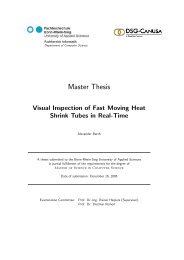Master Thesis - Hochschule Bonn-Rhein-Sieg
Master Thesis - Hochschule Bonn-Rhein-Sieg
Master Thesis - Hochschule Bonn-Rhein-Sieg
You also want an ePaper? Increase the reach of your titles
YUMPU automatically turns print PDFs into web optimized ePapers that Google loves.
6. Evaluating the safety <strong>Master</strong> <strong>Thesis</strong> Björn Ostermann page 104 of 126<br />
Among other values, the EN 13857 [73] gives a maximum height of 120 mm above ground that can be<br />
left free when installing a fence. Thus this value was chosen as the desired value for the programmed<br />
“flexible fence”.<br />
If those 120 mm are applied, the safety distance to the hazard zone has to be 850 mm for the safety of<br />
upper appendages, respectively 1100 mm for the safety of lower appendages.<br />
6.2.2 Safety of machinery – The positioning of protective equipment in respect of<br />
approach speeds of parts of the human body<br />
EN 999:1998<br />
The goal of the project is to safely avoid the collision between robot and humans. When using<br />
protective equipment in this task, in the case of this project the 3D camera combined with the data<br />
evaluating algorithms, safety distances have to be kept to compensate the systems stopping<br />
performance.<br />
The standard EN 999 gives formulas, regarding the positioning of protective equipment in respect of<br />
approach speeds of parts of the human body. Applying those formulas to the present system results in<br />
the necessary safety distance that has to be kept between robot and human at all times.<br />
Critical for the positioning of the protective devices is the overall system stopping performance T<br />
(see Equation 14).<br />
T � t � t<br />
1<br />
Equation 14: Overall system stopping performance, according to [69]<br />
t 1 is the maximum time between the actuation of the sensing function and the output signal switching<br />
devices being in the full state, [69]<br />
t 2 is the maximum response time of the machine, i.e. the time required to stop the machine or remove<br />
the risk after receiving the output signal from the protective equipment. [69]<br />
Since the used 3D camera in this project has a maximum detection capability of below 40 mm in<br />
diameter (20 mm resolution at 4 m distance and 25 mm resolution at 5 m distance, according to [55])<br />
the formula given in chapter 6.1.1 of the standard EN 999 has to be applied to the reaction time<br />
(Equation 15):<br />
2<br />
�K �T<br />
� C<br />
S � �<br />
Equation 15: Minimum distance S from the danger zone to the detection zone [69]<br />
S is the desired distance between the danger zone and the detection zone,<br />
K is a fixed factor:<br />
- 2000 mm/s if S is below or equal to 500 mm














